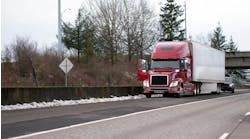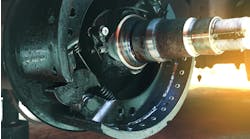It’s something that drivers dread, and something that is a time drain when your truck could be out on the interstate, making money. It’s the manual hours of service (HOS) long transfer process that takes place when a truck is pulled in for an inspection at a weigh station.
Currently, drivers undergoing an in-station inspection need to go through manual steps on an ELD to transfer their logs to the inspector, including entering the officer’s inspector code. This not only takes time, but manual entry leads to input errors. If the driver, for example, mistypes the officer’s inspector code, the officer will be unable to locate them, and it’s an HOS violation. Likewise, if a driver isn’t familiar with the ELD and doesn’t know how to transfer logs, or locate the Driver Instruction Sheet, the carrier can take a hit on its safety score. On the inspector’s side, there is manual entry as well.
It doesn’t have to be that way and technology is available to automate HOS data transfer. We’ve done testing and trials with major fleets and state inspection sites to prove the accuracy and efficiency of electronic inspections—otherwise known as e-Inspections. By transmitting HOS logs and other info before the truck arrives at the inspection site, data “pre-fills” the officer’s inspection report. Law enforcement doesn’t enter anything related to HOS, and neither does the driver. With automated data entry, we found that a “clean” Level III inspection can be reduced from 30-minute detention to mere minutes.
E-inspections aren't just a concept. In fact, participating weigh stations in Maine, Maryland, Michigan, and Virginia recently began accepting electronic inspections. And more states are expressing interest in the new technology.
A little background on how it all works: If you use weigh station bypass, your good-to-great safety score allows you to bypass weigh stations at a rate up to 98% of the time. But, there are times when your trucks will not get the bypass and you’ll be waved in for an inspection. And, that’s where a conundrum can take place. Typically, there are about 3.5 million inspections conducted each year – last year, only 2.7 million were conducted due to COVID-19. That may seem like a lot, but it’s not. A very high percentage of the carrier population has insufficient data to compile complete BASIC percentiles. What’s more, the majority of carriers lack sufficient data to be assessed in even one BASIC.
The reason is a combination of the lack of enforcement officers (13,000 inspection officers as opposed to 6 million trucks that go through weigh stations) and manual paperwork that takes time to complete. That’s why a truck called in for an inspection is often waved on through due to a backlog of trucks waiting to be processed, or a short-staffed inspection site. Sometimes fleets want an inspection to help their safety scores, and even if they ask, they can’t get one.
If they do get the full inspection, it can be time-consuming for both the commercial driver and the inspection officer due to all the manual data entry. E-inspections speed the process, so the inspection officer can do more inspections, allowing safe fleets to bolster their scores, and unsafe fleets to have a bit more scrutiny via more thorough inspections. What’s more, additional inspection data will also reduce the lag time in today’s CSA safety scores that do not always represent a carrier’s existing safety investments and practices.
Today, any fleet that may have had a bad incident and had their safety score negatively impacted may suffer from lower scores long after incidents occur, regardless of changes in safety practices. More inspections would increase data sufficiency in CSA, reduce lag time in adjusting a safety score, validate, and reward a carrier’s current safety performance.
It’s clear that front-line CVE agencies need a better method of conducting inspections. And, carriers need more available options to impact their CSA scores—especially when you consider freight volume across the U.S. is expected to grow by 36% by 2031. This could be just the start. There could be a day where fully electronic Level VIII inspections, for example, could be conducted. A truck could drive by a weigh station with all the vehicle and driver information already having been received in advance by the inspection site. And, that data would be received, and the carrier and agency would get credit for a "virtual" inspection.
All told, there is change in the air when it comes to weigh station inspections. And new technology designed to automate inspection processes will help inspectors focus their time on the trucks that truly do need inspecting while at the same time save drivers and fleets time and money.
Sara Steele is a product manager and director of compliance at Drivewyze, a leading connected truck services provider and operator of the largest public-private weigh station bypass network in North America. She has over a decade of experience in the trucking software industry, particularly in areas of regulatory compliance. In addition to her role with Drivewyze, Sara is secretary for the CVSA Enforcement and Industry Modernization Committee.



